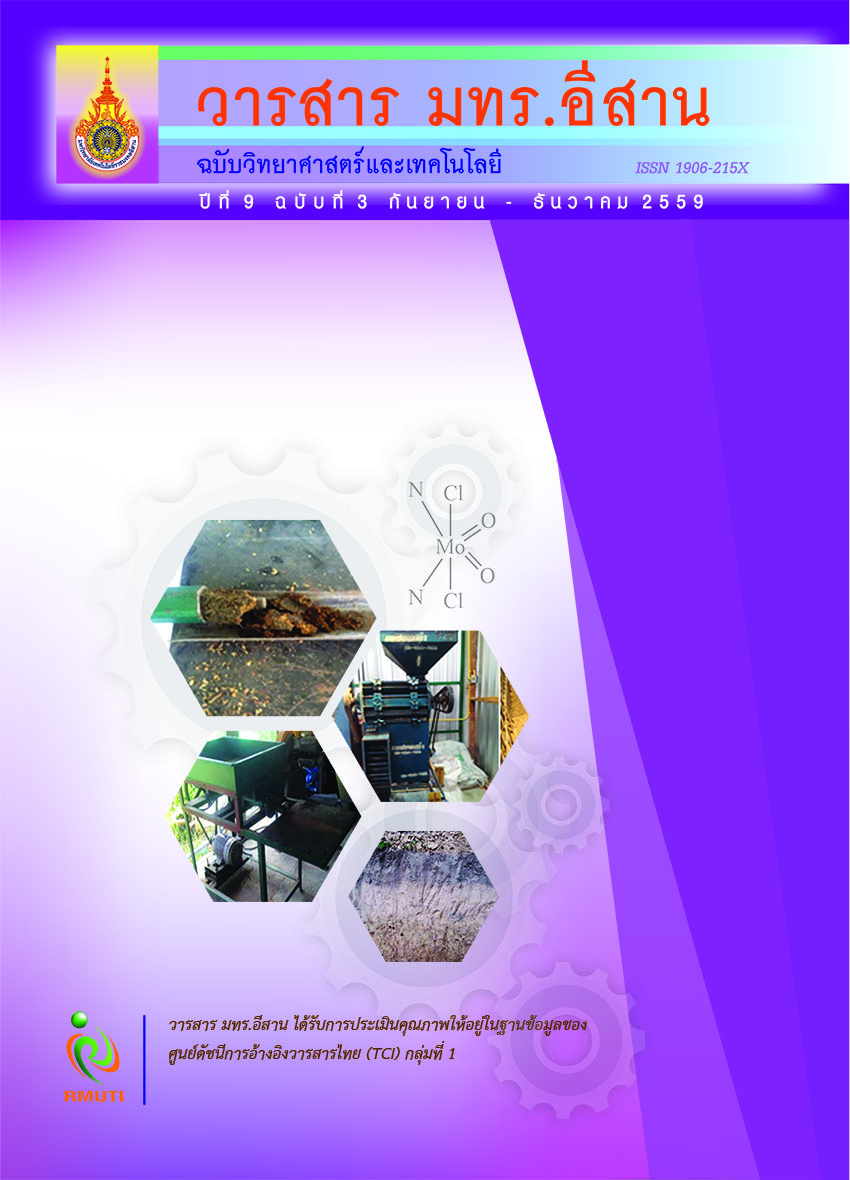การพัฒนาแท่งเชื้อเพลิงจากชีวมวลเหลือทิ้งวิสาหกิจชุมชนกาแฟสดแม่ตอน อำเภอดอยสะเก็ด จังหวัดเชียงใหม่ Development of Fuel Briquettes from Biomass Residues of Mae-Ton Fresh Coffee SMEs in Doisaket District, Chiangmai Province
Main Article Content
Abstract
บทคัดย่อ
การศึกษานี้มีวัตถุประสงคเ์ พื่อพัฒนาแทง่ เชื้อเพลิงจากชีวมวลเหลือทิ้ง (กะลากาแฟและเยื่อหุม้ เมล็ดกาแฟ)
ของกลุม่ วิสาหกิจชุมชนกาแฟสดแมต่ อนดว้ ยวิธีการอัดขึ้นรูปแบบอัดมือและแบบเครื่องอัด รวมทั้งประเมิน
คุณสมบัติของแท่งเชื้อเพลิงทางกายภาพ ทางเคมี และค่าความร้อน รวมถึงประสิทธิผลภายใต้สภาวะ
การใช้งานจริงของแท่งเชื้อเพลิง ผลการศึกษาพบว่า ชีวมวลเหลือทิ้งมีศักยภาพด้านพลังงานความร้อน
และสามารถพัฒนาอัดขึ้นรูปเป็นแท่งเชื้อเพลิงด้วยวิธีการอัดมือ เงื่อนไขที่เหมาะสมของการศึกษานี้ คือ
อัตราส่วนผสมของตัวประสาน (แป้งเปียก) ที่ร้อยละ 10.5 โดยมวล พบว่าระยะเวลาที่ใช้ในการอัดต่อก้อน
ประมาณ 1 - 1.5 นาที แท่งเชื้อเพลิงที่ได้มีลักษณะผิวเรียบ รูปร่างตรง มีสภาพการคงรูปสูง และ
ให้ค่าความร้อนเฉลี่ยเท่ากับ 4,160 แคลอรี่ต่อกรัม การเผาไหม้แท่งเชื้อเพลิง (จำนวน 5 ก้อน/มวล
250 - 260 กรัม) พบวา่ ระยะเวลาในการจุดติดไฟแทง่ เชื้อเพลิง ระยะเวลาที่ใชต้ ม้ น้ำจนเดือด และความนาน
ในการติดไฟจนกลายเป็นเถ้า เท่ากับ 2 นาที 10 นาที และ 53 นาที ตามลำดับ สีของเปลวไฟมีลักษณะเป็น
สีแดงและไม่พบปัญหาด้านควัน กลิ่น รวมทั้งสะเก็ดไฟ
Abstract
This study aimed to develop fuel briquette from biomass residues (parchment and
silver skin) of Mae-Ton Fresh Coffee SMEs by using mechanical extruder and manual
compactor tool. Physical and chemical properties, heating value, and the effectiveness
of fuel briquette use were examined. Results showed that biomass residues offering
potential source of heat energy could be manually compressed to form fuel briquette.
The briquette with mixed starch binder at 10.5% (by mass) was an appropriate condition
and was produced at a rate of 1 briquette per 1 - 1.5 minute by using manual compactor
technique. With good visual and physical quality (straight and smooth briquette form)
and easily stored fuel, the heating value gained was 4,160 Cal/g. With burning the
briquettes (5 pieces/250 - 260 g) the duration of ignition, boiling, and combustion were 2,
10, and 53 min respectively. It produced red flame, smokeless and odorless fuel
briquette without fire flakes.
Article Details
References
[2] Solange, I.M., Ercillia, M.S.M., Silvia, M. and Jose, A.T. (2011). Production, Composition, and Application of Coffee and its Industrial Residues. Food Bioprocess Technology. Vol. 4. pp. 661-672
[3] Department of Industrial Works. (2012). Guidelines and Criteria of Waste Property for the Production of Fuel Briquette and Block. Access (10 May 2015). Available (https://www.diw.go.th)
[4] Kondamudi, N., Mohapatra, S.K. and Misra, M. (2008). Spent Coffee Grounds as a Versatile Source of Green Energy. Journal of Agricultural and Food Chemistry. Vol. 56. pp. 11757-11760
[5] Jamradloedluk, J. and Wiriyaumpaiwong, S. (2007). Production and Characterization of Rice Husk Based Charcoal Briquetts. KKU Engineering Journal. Vol. 34. No. 4. pp. 391-398
[6] Jolanun, B., Phutharukchat, A. and Khamtui, C. (2011). Community-Based Renewable Energy from Mimosa Pigra L. Charcoal Briquettes. KKU Research Journal. Vol. 16. No. 1. pp. 20-31
[7] Mahayosanon, T. (2005). Design and Fabrication of Coal Briquette Machine for Household. M.Eng. (Agriculural Engineering) Thesis, Kasetsart University. (in Thai)
[8] Watanajeera, L., Panyaping, K. and Neungkamkong, K. (2012). The Development of Fuel Briquette from Longan Biomass Residue. Research report of Rajamangala University of Technology Lanna. (in Thai)
[9] McDougal, O., Eidemiller, S. and Weires, N. (2010). Biomass Briquettes: Turning Waste Into Energy. Access (27 December 2015). Available (https://www.biomassmagazine.com)
[10] Chunniyom, C. (2010). Study on the Value Added of Corncob Waste to Produce the Fuel Briquettes. M.Sc. (Chemical Engineering) Thesis, Thammasart University.) (in Thai)
[11] Malithong, A. (1989). An Investigation on Green Fuel Production from Water Hyacinth and Water Hyacinth Mixed with Lignite. M.Sc. (Environmental Sceince) Thesis, Kasetsart University. (in Thai)


